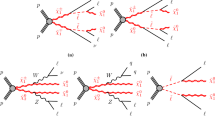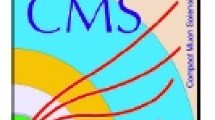Abstract
A search for the electroweak production of charginos and sleptons decaying into final states with two electrons and/or muons is presented. The analysis is based on 139 fb–1 of proton-proton collision data recorded by the ATLAS experiment at the Large Hadron Collider (LHC) at \(\sqrt s = 13\) TeV. Three R-parity-conserving scenarios are considered: the direct production of lightest chargino pairs with decays mediated by either W bosons or sleptons and the direct production of slepton pairs. No significant deviations from the Standard Model expectations are observed and limits at 95% Confidence Level (CL) are set on the masses of the relevant supersymmetric particles in each of these scenarios.
Similar content being viewed by others
Explore related subjects
Discover the latest articles, news and stories from top researchers in related subjects.Avoid common mistakes on your manuscript.
1 INTRODUCTION
Supersymmetry (SUSY) is a theoretical extension of the Standard Model (SM) that, if realized in nature, would solve the hierarchy problem by introducing supersymmetric partners (sparticles) of the particles in the SM. In R-parity-conserving [1] models, sparticles must be produced in pairs. The superpartners of the SM Higgs boson and the electroweak gauge bosons (electroweakinos) mix to form chargino (\(\mathop {\tilde {\chi }}\nolimits_i^ \pm \), i = 1, 2) and neutralino (\(\mathop {\tilde {\chi }}\nolimits_j^0 \), \(j = 1,2,3,4\)) mass eigenstates, ordered by increasing mass. Direct electroweakino production would dominate SUSY production at the LHC if gluinos and squarks were much heavier than low-mass electroweakinos.
This paper presents a search [2] for the electroweak production of charginos and sleptons (\(\tilde {\ell }\) or \(\tilde {\nu }\)) decaying into final states with two oppositely charged leptons (electrons and/or muons) and significant \({\mathbf{p}}_{{\text{T}}}^{{{\text{miss}}}}\) (\(E_{{\text{T}}}^{{{\text{miss}}}}\) referred to as the magnitude) using 139 fb–1 of proton-proton collision data recorded by the ATLAS [3] detector at the LHC at \(\sqrt s = 13\) TeV.
Three R-parity-conserving scenarios are presented, based on simplified models [4], and the corresponding diagrams are reported in Fig. 1. The analysis strategy is optimized to target the search for the direct production of \(\mathop {\tilde {\chi }}\nolimits_1^ + \mathop {\tilde {\chi }}\nolimits_1^ - \) where each \(\mathop {\tilde {\chi }}\nolimits_1^ \pm \) decays into the \(\mathop {\tilde {\chi }}\nolimits_1^0 \) and an on-shell \(W\) boson, then it is applied to the other two searches: the direct production of \(\mathop {\tilde {\chi }}\nolimits_1^ + \mathop {\tilde {\chi }}\nolimits_1^ - \), where each \(\mathop {\tilde {\chi }}\nolimits_1^ \pm \) decays into a \(\tilde {\ell }\)-\(\nu \)/\(\tilde {\nu }\)-\(\ell \) pair and the \(\mathop {\tilde {\chi }}\nolimits_1^0 \) (the slepton/sneutrino masses are chosen to be midway between the mass of the chargino and that of the lightest neutralino); the direct pair production of \(\tilde {\ell }\), where each \(\tilde {\ell }\) decays into a lepton and the \(\mathop {\tilde {\chi }}\nolimits_1^0 \). Lepton flavour is conserved in all models.
Diagrams of the SUSY models considered: (a) \(\mathop {\tilde {\chi }}\nolimits_1^ + \mathop {\tilde {\chi }}\nolimits_1^ - \) production with W-boson-mediated decays, (b) \(\mathop {\tilde {\chi }}\nolimits_1^ + \mathop {\tilde {\chi }}\nolimits_1^ - \) production with \(\tilde {\ell }\)/\(\tilde {\nu }\)-mediated decays and (c) slepton pair production.
2 ANALYSIS STRATEGY AND RESULTS
Events are required to have exactly two oppositely charged leptons, both with \({{p}_{T}} > 25\) GeV. To remove contributions from low-mass resonances and to ensure a good SM background modeling, the invariant mass of the two leptons must be \({{m}_{{{{\ell }_{1}}{{\ell }_{2}}}}} > 100\) GeV. Events are further required to have no reconstructed b-jets, to suppress contributions coming from processes with top quarks. Selected events must also satisfy \(E_{{\text{T}}}^{{{\text{miss}}}} > 110\) GeV and \(E_{{\text{T}}}^{{{\text{miss}}}}\) significance [5] \(\mathcal{S} > 10\). Events are separated into “Different Flavour” and “Same Flavour,” the latter requiring to have the dilepton invariant mass far from the Z peak, \({{m}_{{{{\ell }_{1}}{{\ell }_{2}}}}} > 121.2\) GeV to reduce dibosons and Z+jets backgrounds. Events are further classified by the multiplicity of non-b-tagged jets. Following the classification of the events, two sets of signal regions (SRs) are defined, a set of exclusive SRs for a shape fit approach, to maximize model-dependent search sensitivity, and a set of inclusive SRs, to be used for model-independent results, both defined by specific ranges of the \({{m}_{{{\text{T}}2}}}\) variable [6], called stransverse mass.
The main irreducible backgrounds come from SM diboson (WW, WZ, ZZ) and top-quark (\(t\bar {t}\) and Wt) productions. They are estimated from simulated events, normalized using a simultaneous likelihood fit [7] to data in dedicated control regions (CRs). Three CRs are used: the first one targeting WW production; the second one targeting WZ and ZZ production and the last one targeting \(t\bar {t}\) and single-top-quark production.
The normalizations of the relevant backgrounds are then validated in a set of validation regions (VRs), which are not used to constrain the fit, but to verify that the data and predictions agree within uncertainties in regions of the parameter space kinematically close to the SRs. Six VRs are defined: for the WW background two regions are considered, according to the multiplicity of non-b-tagged jets; since contributions from the top-quark background are not negligible in these two regions, three VRs are defined for the top background. Finally, one VR is considered for the WZ and ZZ diboson productions.
All relevant sources of experimental and theoretical systematic uncertainty are included in the likelihood fit, with the dominant ones being related to theory uncertainties in the Monte Carlo modelling. The background coming from fake or non-prompt leptons is estimated using a data-driven technique, known as Matrix Method [8]. No significant deviations from the SM expectations are observed in any of the SRs considered. Exclusion limits at 95% CL are set on the masses of the sparticles considered in the three models, as shown in Fig. 2. In the model of direct chargino pair production with W-boson-mediated and \(\tilde {\ell }\)/\(\tilde {\nu }\)-mediated decays, for a massless lightest neutralino, \(\mathop {\tilde {\chi }}\nolimits_1^ \pm \) masses up to 420 GeV and 1 TeV are excluded at 95% CL, respectively. In the model of direct slepton pair production, slepton masses up to 700 GeV are excluded at 95% CL for a massless \(\mathop {\tilde {\chi }}\nolimits_1^0 \). Model-independent upper limits at 95% CL on the visible signal cross-section of processes beyond the SM are also derived. These results significantly improve upon previous exclusion limits for the same scenarios.
Observed and expected exclusion limits on SUSY simplified models for chargino-pair production with (a) W-boson-mediated decays, (b) slepton/sneutrino-mediated decays and for (c) slepton-pair direct production. All limits are computed at 95% CL. The blue line in (b) corresponds to the projection of the observed limit for the superpartners of the left-handed charged leptons into this model, according to the slepton mass hypothesis.
REFERENCES
G. R. Farrar and P. Fayet, “Phenomenology of the Production, Decay, and Detection of New Hadronic States Associated with Supersymmetry,” Phys. Lett. B 76, 575 (1978). https://doi.org/10.1016/0370-2693(78)90858-4
ATLAS Collaboration, “Search for Electroweak Production of Charginos and Sleptons Decaying into Final States with Two Leptons and Missing Transverse Momentum in \(\sqrt s = 13\) TeV pp Collisions Using the ATLAS Detector,” Eur. Phys. J. C 80, 123 (2020). https://doi.org/10.1140/epjc/s10052-019-7594-6
ATLAS Collaboration, “The ATLAS Experiment at the CERN Large Hadron Collider,” JINST 3, S08003 (2008). https://doi.org/10.1088/1748-0221/3/08/s08003
J. Alwall, P. Schuster, and N. Toro, “Simplified Models for a First Characterization of New Physics at the LHC,” Phys. Rev. D 79, 075020 (2009). https://doi.org/10.1103/physrevd.79.075020
ATLAS Collaboration, “Object-Based Missing Transverse Momentum Significance in the ATLAS Detector.” https://cds.cern.ch/record/2630948, 2018.
A. Barr, C. G. Lester, and P. Stephens, “A Variable for Measuring Masses at Hadron Colliders when Missing Energy is Expected; \({{m}_{{T2}}}\): the Truth Behind the Glamour,” J. Phys. G 29, 2343 (2003). https://doi.org/10.1088/0954-3899/29/10/304
M. Baak et al., “HistFitter software framework for statistical data analysis,” Eur. Phys. J. C 75, 153 (2015). https://doi.org/10.1140/epjc/s10052-015-3327-7
ATLAS Collaboration, “Measurement of the Top Quark-Pair Production Cross Section with ATLAS in pp Collisions at \(\sqrt s = 7\) TeV,” Eur. Phys. J. C 71, 1577 (2011). https://doi.org/10.1140/epjc/s10052-011-1577-6
Author information
Authors and Affiliations
Corresponding author
About this article
Cite this article
Gravili, F.G. Search for Electroweak Production of Charginos and Sleptons Decaying into Final States with Two Leptons and Missing Transverse Momentum at LHC Run 2 with the ATLAS Detector. Bull. Lebedev Phys. Inst. 48, 46–48 (2021). https://doi.org/10.3103/S1068335621020044
Received:
Revised:
Accepted:
Published:
Issue Date:
DOI: https://doi.org/10.3103/S1068335621020044






